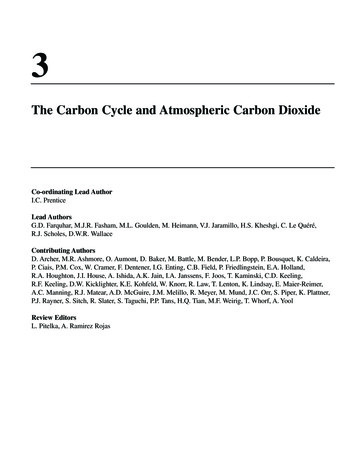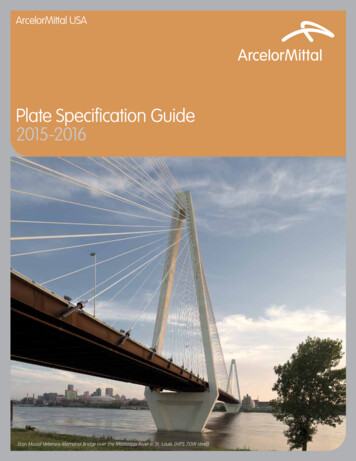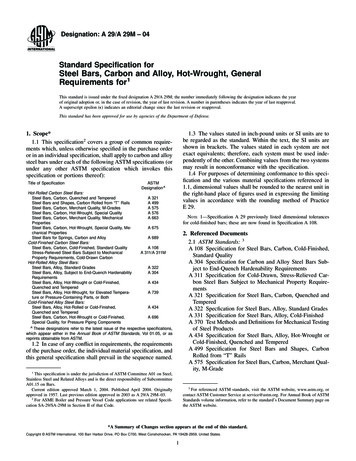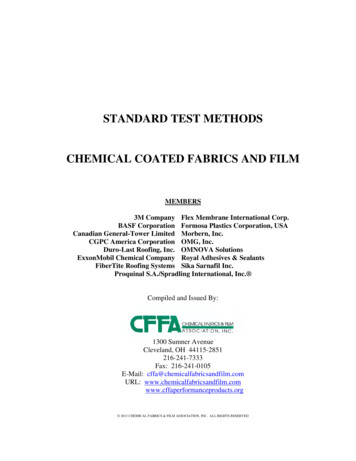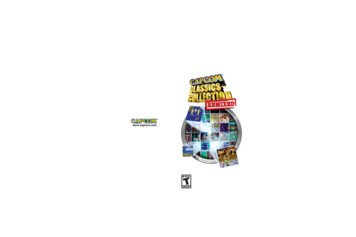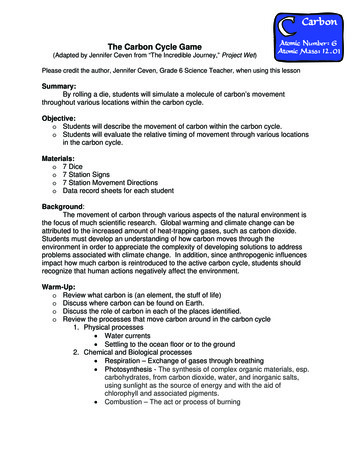
Transcription
The Carbon Cycle Game(Adapted by Jennifer Ceven from “The Incredible Journey,” Project Wet)Please credit the author, Jennifer Ceven, Grade 6 Science Teacher, when using this lessonSummary:By rolling a die, students will simulate a molecule of carbon’s movementthroughout various locations within the carbon cycle.Objective:o Students will describe the movement of carbon within the carbon cycle.o Students will evaluate the relative timing of movement through various locationsin the carbon cycle.Materials:o 7 Diceo 7 Station Signso 7 Station Movement Directionso Data record sheets for each studentBackground:The movement of carbon through various aspects of the natural environment isthe focus of much scientific research. Global warming and climate change can beattributed to the increased amount of heat-trapping gases, such as carbon dioxide.Students must develop an understanding of how carbon moves through theenvironment in order to appreciate the complexity of developing solutions to addressproblems associated with climate change. In addition, since anthropogenic influencesimpact how much carbon is reintroduced to the active carbon cycle, students shouldrecognize that human actions negatively affect the environment.Warm-Up:o Review what carbon is (an element, the stuff of life)o Discuss where carbon can be found on Earth.o Discuss the role of carbon in each of the places identified.o Review the processes that move carbon around in the carbon cycle1. Physical processes Water currents Settling to the ocean floor or to the ground2. Chemical and Biological processes Respiration – Exchange of gases through breathing Photosynthesis - The synthesis of complex organic materials, esp.carbohydrates, from carbon dioxide, water, and inorganic salts,using sunlight as the source of energy and with the aid ofchlorophyll and associated pigments. Combustion – The act or process of burning
Dissolving gaseous carbon dioxide into water, where it takes theform of carbonic acidComing out of solution of carbonic acid to become carbon dioxidein the air (same process that occurs when you open a soda )Death and Decomposition - breakdown or decay of organic matterThe Activity:1. Tell students that they are going to be carbon atoms moving through the carboncycle.2. Categorize the places carbon can be found into these stations: Atmosphere,Plants, Animals, Soil, Ocean, Deep Ocean, and Fossil Fuels. Point out the areasof the room that are labeled with each station and contain the directions formovement from that station.3. Assign students to each station randomly and evenly. Have students identify thedifferent places carbon could go from that given station. Discuss the processesthat allow for the transfer of carbon between stations. Students should make aline and roll the die individually to follow the directions for movement from (orretention at) each station. Remind them that they are representing atoms ofcarbon moving through the carbon cycle and that they should record theirmovements on the data sheet.4. Students will realize the routine movements (or non-movements) in the carboncycle.5. Once the carbon atoms (students) have had a chance to roll the die ten times,have each student create a bar graph using the data they collected. The bargraph should represent the number of times the carbon atom (student) was ateach station.6. Using graph paper, create a large bar graph recording the number of carbonatoms (students) at each station.Wrap-Up and Action Plan:o Ask a few students to tell the story of how their carbon atom moved through thecycle.o Discuss the results – using the bar graph have the students explain where themost/least amount of carbon was in the cycle?Assessment:o Rate students’ understanding on their responses from class or groupdiscussions.o Assign a follow-up activity:o Role-play the motion of carbon throughout the carbon cycle.o Write a story about your carbon atom as it moved through the carboncycle.
The Carbon CycleREFERENCE PAGEImage Source: http://www.bigelow.org/foodweb/carbon cycle.jpg
The Carbon CycleDATA RECORD SHEETRecord the places you have traveled as a carbon molecule.Student’s Name:Station Stop1.2.3.4.5.6.7.8.9.10.What HappensDestination
The Carbon CycleTHE ATMOSPHEREYou are currently a molecule of carbon dioxide in the atmosphere.If you roll Then you 1Stay in the atmosphere. Much of the carbon dioxide in theatmosphere moves through the atmosphere.2Go to plant. You are used by a plant in photosynthesis.3Stay in the atmosphere. Much of the carbon dioxide in theatmosphere moves through the atmosphere.4Stay in the atmosphere. Much of the carbon dioxide in theatmosphere circulates through the atmosphere.5Go to surface ocean.6Go to plant. You are used by a plant in photosynthesis.
The Carbon CyclePLANTSYou are currently a carbon molecule in the structure of the plant.If you roll Then you 1Go to soil. The tree shed its leaves.2Stay in plant. You are a carbon molecule in the tree’s trunk.3Go to animal. The leaves and berries that the plant producedcontain your carbon molecule and were eaten.4Stay in plant. You are a carbon molecule in the tree’s roots.5Stay in plant. You are a carbon molecule in the tree’sbranches.6Stay in plant. You are a carbon molecule in the tree’s trunk.
The Carbon CycleANIMALSYou are currently a molecule of carbon in an animal.If you roll Then you 1Stay in animal. The carbon molecule is stored as fat in theanimal.2Go to soil. The animal that consumed you died and yourcarbon molecule is returned to the soil.3Go to atmosphere. The animal that consumed you respired(breathed) you out as carbon dioxide.4Stay in animal. You are eaten by a predator.5Go to atmosphere. The animal that consumed you respired(breathed) you out as carbon dioxide.6Go to atmosphere. The animal that consumed you respired(breathed) you out as carbon dioxide.
The Carbon CycleSOILYou are currently a molecule of carbon dioxide in the soil.If you roll Then you 1Stay in the soil. Much of the carbon in the soil is stored there.2Go to plant. You are used by a plant in photosynthesis.3Go to fossil fuels. Your carbon molecule has been in the soilso long it turns into fossil fuels.4Go to the atmosphere.5Stay in the soil.6Go to fossil fuels. Your carbon molecule has been in the soilso long that it turns into fossil fuels.
The Carbon CycleSURFACE OCEANYou are currently a molecule of carbon dioxide in the surface ocean.If you roll Then you 1Go to deep ocean.2Stay in the surface ocean.3Go to deep ocean. Your carbon atom was part of an oceanorganism that has died and has sunk to the bottom of theocean.4Stay in the surface ocean.5Go to the atmosphere.6Go to the atmosphere.
The Carbon CycleDEEP OCEANYou are currently a molecule of carbon in the deep ocean.If you roll Then you 1Stay in the deep ocean.2Stay in the deep ocean.3Go to surface ocean.4Go to surface ocean.5Go to surface ocean.6Go to animal. An organism in the water has taken you up asfood in the deep ocean.
The Carbon CycleFOSSIL FUELSFossil fuels are a rich source of energy that has been created from carbon that hasbeen stored for many millions of years.If you roll Then you 1Stay in the fossil fuels.2Stay in the fossil fuels.3Stay in the fossil fuels.4Stay in the fossil fuels.5Go to the atmosphere. Humans have pumped the fuel thatyou are part of out of the ground and have used it to powertheir cars.6Go to the atmosphere.
.Groupsshouldhave 3 students.Each studentchoosesa playingpiece.Thisplayingpiecerepresentsa carbonatom.Each groupneeds2 coinsand a playingboard.Each personrequiresa questionsheetand a copy ofthe playingboard.The groupneedssome coloredpencils.2.Place your playingpieceson space #1.Flipthe coinsas instructedon the followingpages.Flipyour coinsat the startof the turnfollowinginstructionsas you go.Do not followthe sequence of thenumbers,followthe chance moves thatthe coinspresent.Two or moreplayerscan occupy the same place.When your carbon atom is returnedtothe atmosphere,you have completedone cycle.Continueplayinguntiltoldto stop.3.On your individualgame board,use the coloredpencilsto keep trackof your cycleswitheach colorrepresentinga singlecycle.Label thecyclesIst,2nd, etc.Everyonewho travelsthroughthe cycleandunderstandsthe processis a winner.BUT,for"fun"1)Who visitedthe most organisms2)Who completedthe most cycles3)who completedthe longestcycle?the shortest?4)Who spends the most time in the atmosphere?4.toHave funtape thissheetthen answerin as well.thequestionsDISCUSSIONinyourlabbook.Be sureQUESTIONS1.For the sake of time and space,some importantpathwayshave beenleftout of the game.Note these pathwaysand describehow carbon atomsmightenterintoand cyclethroughthese pathways.In particular,notethe aquaticand fossilfuelpathways.2.Increated?changedthe courseof the carbon cycle,Ever destroyed?Ever changedintoothercompounds? Explain.are carbonintootheratomskindsthemselvesof atoms?everEver3.What changes do occurin the stateof carbonatoms in the courseofthe cycle?Describethe organicand inorganicstatesof carbon and thechanges thatoccur between these states.4.Why are some carbonatoms from Carbon Dioxidenotsugar moleculesin darkness?Startby answering:Whatenergyof carbon dioxide?Of sugar?What is necessarya higherphase?5.Much ofrespiration.thisprocess6.Whatthe food ingestedintoeachWhy is thisso?What doesand how does it get it?happenstocarbon7.(SUMMARY) Why isthe variousorganisms?and used by.atomsa naturalIn chartasorganismisthe organisma resultecosystemnotform,discussofincorporatedintois the potentialfor them to 90 tometabolizedin cellneed and get out ofrespiration?pollutedwaste,by wastesfromfrom what organism
f/.CO2 In the.: .atmosphere'-.- -.""""'-.:0-----. -6."'7.DETRITUS deadorganicmatterFIRE-- - :(10.'0--; detr1tus - -- --feedersanddecomposers1,,: 1.- )
NOTE:H headsT TailsCARBONFlipSTART1.2.CYCLE2 coinsATNUMBER unlessyouaretoldotherwise1YOUR CARBON ATOM IS NOW A MOLECULE OF CO2 IN THE ATMOSPHERE.f1!.Q coinsTTNot absorbed;yourcarbonatom remainsin the atmosphereanotherturn.TH or HH yourcarbonatom is absorbedintoa leafof a plant.to number2THE MOLECULE OF CO2 WITH YOUR CARBON ATOMPLANT.ili:p. coinsTTNO SUNLIGHT!NO photosynthesis.thecarbon atom returnsto the atmosphere.TH or OH SUNLIGHT!Photosynthesis.Tourincorporatedintoa sugar moleculebynumber 3.forGoIS NOW IN A LEAF OF ACO2 moleculewithyourGo back to #1.carbon atom isphotosynthesis.Go to3.YOUR CARBON ATOM IS NOW IN A MOLECULE OF SUGAR IN A PLANTil.!.Q .t.wQ CO! n STTthe sugar moleculewith your carbon atom is oxidizedin cellrespirationto provideenergyfor plantgrowth.your carbonatom is releasedin a moleculeof CO2.Go back to number 1.TH or HH the sugar moleculewith your carbonatom is incorporatedintoa moleculemaking up the tissueof a plant.Go to spaceNumber 4.4.YOUR CARBON ATOM IS NOW IN A MOLECULE OF SUGAR IN A PLANT. coinsTTThe plantis eatenby an animal.go to Number5 and takeanotherturnto determinewhatkindof animal.TU or HH plantpartdies.itsorganicmatteris detritus.Go toNumber6.5.THE PLANT TISSUE WITH YOUR CARBON ATOM IS EATEN BY A PRIMARYCONSUMER .EliP. Q!1§ Q!!! t w i c e .T & Tmammal herbivore--goto SAT & Hbird--goto SBH & Tinsect--goto SCH & Hhuman,perhapsyourself--goto 96.YOUR CARBON ATOM IS NOW IN A MOLECULE OF DEAD ORGANICDETRITUS.fJJ:,Q coinsTT or THconsumedby a detritusfeederor decomposer.takeanotherturnto determinewhichone.HHFIRE!go to 7.7.MATTER ORTHE MOLECULEWITH YOUR CARBON ATOM IS NOW BEINGOXIDIZEDA FIRE.OXYGEN IS COMBINGWITH YOUR CARBON ATOM AND ITRELEASEDIN A MOLECULEOF CARBON DIOXIDE.GO IMMEDIATELYNUMBER 1 WITHOUTTAKINGA TURN .Go to10 and(BURNED)IS BEINGBACK TOIN
SA, SB AND SC THE PLANT TISSUE WITH YOUR CARBON ATOM IS NOW BEINGINGESTED BY A PRIMARY CONSUMERAS PART OF ITS FOOD.fli:P- coinsTTthe moleculewith your carbon atom is metabolizedintoamoleculemaking a tissueof the consumer'sbody.go to 11PTHCELL RESPIRATION!Go to 12.HHthe moleculewith your carbonatom is not digested.it passesthroughthe intestinaltractas fecalwaste.--goto 6.9.THE PLANT TISSUE WITH YOUR CARBON ATOM IS NOW BEING INGESTED BYA HUMAN --PERHAPSYOURSELF, AS A PART OF FOOD .Kl.!.Q coinsTTthe moleculewithyourcarbonatom is metabolizedintoamoleculemakingup a tissuein yourbody.Go to 11HTHCELL RESPIRATION!Go to 12HHthe moleculewithyourcarbonatom is not digested,Itpassesthroughtheintestinaltractand out as fecalwaste.Go tonumber6.THE MOLECULE CONTAININGYOUR CARBON ATOM IS NOW BEING INGESTED BY APRIMARY DETRITUSFEEDER OR DECOMPOSER.t;li:Q Qillt wi c e .TTearthwormgo to 15ETHdecomposer--fungus(mushroom)Go to 15FHTdecomposer--bacteriaDo to 15BHHinsect--goto 15I11H. YOUR CARBON ATOM IS NOW IN A MOLECULE MAKING UP A TISSUE OF YOUR ORANOTHER HUMANI S BODY.E!!.Q Q1nTthe moleculeis brokendown and metabolizedrespiration,--goto 12Hwhen the human dies of injuryand/ordiseasecremated,the carbon atom willgo to numberYOUR CARBON ATOMPRIMARY CONSUMERil.!.Q coinsTTthe molecule--goto 12.THthe primaryGo to 13HHthe primary115IS NOW IN A MOLECULE MAKINGOR fandbycelland if7.UP A TISSUEmetabolizeda secondaryinjuriesinand/orincellthebodyisOF Arespirationconsumer.disease.gotoYOUR CARBON ATOM IS NOW IN A MOLECULE MAKING UP A TISSUE OF ASECONDARY CONSUMER OR A CARNIVORE .EliQ coinsTTthe moleculeis brokendown and metabolizedin cellrespiration--goto 12.THthesecondaryconsumeris eatenby a thirdorderconsumer.Go to 14HHthe secondaryconsumerdiesof injuriesand/ordisease.Go to 6.6.
IlTYOUR CARBON ATOM IS NOW IN A MOLECULE MAKING UP A TISSUE OF A THIRDORDER CONSUMER OR A CARNIVORE .n.!.:P- coinsTTthe moleculeis brokendown and metabolizedin cellrespiration--goto 12.THthethirdorderconsumeris eatenby anotherthirdorderconsumer.Go to 14HHthe thirdorderconsumerdiesof injuriesand/ordisease.Go to 6.12.THE MOLECULE CONTAINING THE CARBON ATOM IS NOW BEING BROKEN DOWN INCELL RESPIRATION TO PROVIDE ENERGY FOR THE CONSUMER'S MOVEMENTS ANDFUNCTIONS.IN THIS PROCESS, YOUR CARBON ATOM IS COMBINED WITH OXYGENATOMS AND IS RELEASED BACK INTO THE AIR AS CARBON DIOXIDE.Goimmediatelyback to number 1 withouttakinganotherturn.13.THE MOLECULE WITH YOUR CARBON ATOM IS NOW BEING INGESTED BY ASECONDARY CONSUMER .lliJ2 coinsTTthe moleculeis metabolizedintoa moleculemakingup a tissuesof theconsumer'sbody.Go to 11STHCELL RESPIRATION!.Go to 12.88the moleculewithyourcarbonatom is notdigested.itpassesthroughtheintestinaltractand out as fecalmatter.Go to 614.THE MOLECULE WITH YOUR CARBON ATOM IS NOW BEING INGESTED BY A COW -A CONSUMER .n.!.Q coinsTTthe moleculeis metabolizedintoa moleculemakingup a tissuesof theconsumer'sbody.Go to llTTHCELL RESPIRATION!.Go to 12.HHthe moleculewithyourcarbonatom is not digested.itpassesthroughtheintestinaltractand out as fecalmatter.Go to 6.15BTHE MOLECULE WITH YOUR CARBON ATOM IS NOW BEING ABSORBED BY ABACTERIA.El.iQ Titgetsincorporatedintoa moleculeof the bacteria-gotoHitgetsbrokendown and metabolizedin cellrespiration-go to 12.1615E THE MOLECULE WITH YOUR CARBON ATOM IS NOW BEING INGESTED BY ANEARTHWORM.E!.i.Q coinsTTit gets incorporatedintoa moleculeof the worm's body.Go to17.THit gets brokendown and metabolizedin cellrespiration.Go to12.HHit is not digested;it passes throughthe intestinaltractandout as fecalmatter.Go to number 6
15FTHE MOLECULE WITH YOUR CARBON ATOM IS NOW BEING ABSORBED BY A ntoa moleculeof thefungus.--goto18.Hitgetsbrokendown and metabolizedin cellrespiration--goto 12.151THE MOLECULE WITH YOUR CARBON ATOM IS NOW BEING INGESTED BY ANINSECT GRUB.Flip coinsTTit gets incorporatedintoa moleculeof the insectsbody.Go to 19.THCELL RESPIRATION!.Go to 12.HHit is not digested.it passes throughthe intestinaltractout as fecalwaste.Go back to 616YOUR CARBON MOLECULE IS NOW A MOLECULE MAKING UP THE BACTERIA'SBODY.EliRTTTHHHYOUR17BODY.niRTTTHHH18 ONtois brokendown and metabolized12.is eatenby an earthworm--godies,--Goto 6.MOLECULEISNOW A MOLECULEMAKINGUP coinsthe moleculeis brokendown and metabolized--gobackto 12.the worm is eatenby an bird--goto 15Ethe worm diesof injuryor disease--gotoincellto15ETHEinrespirationEARTHWORM I Scellrespiration6.YOUR CARBON MOLECULE IS NOW A MOLECULE MAKING UP A MUSHROOM.niP coinsTTthe moleculeis brokendown and metabolizedin cellrespiration--gobackto 12.THthe mushroomis eatenby an insect--goto 151HHthe mushroommaturesand dies--Goto 619YOUR CARBON MOLECULE IS NOW A MOLECULE MAKING UP THE BODY OF ANINSECT.Eli:P. coinsTTthe moleculeis brokendown and metabolizedin cellrespiration--gobackto 12.THtheinsectis eatenby a smallmammal.--goto 8AHHtheinsectdiesof injuryor disease--goto 6.and
Carbon, Climate, and Laser TechnologyThe Carbon Cycle Pursuit GameTeacher’s GuideSubject Focus:Earth ScienceBiologyChemistryMaterials & PreparationsTime:Preparation: 30 minutesto make one game,although the process canbe greatly expedited byinvolving studentsIntroduction: 10 minutesPlaying time: 30 minutesMaterials: game board game instructions (can beaffixed to back side ofgame board) 7 dice, one color-codedto correspond to a specificcarbon reservoir 7 color-coded sets of tenquestion cards corresponding to a specific carbonreservoir 1 game piece token/markerper teamTeacher Materials:See Assembly Instructionsthat follow www.atd.ucar.edu/apol/biocomplexity www.eo.ucar.eduNational Science Content Standards Addressed:Standards C, D, and FLearning Objectives: Learn the biological carbon cycle as each team moves as carbonthrough the atmosphere, oceans, biosphere, and lithosphere Correctly identify and use the terms carbon source, sink, and reservoir Learn about human’s role today in impacting the carbon cycle Understand that the carbon cycle is a dynamic system that plays asignificant role in Earth’s atmospheric composition Understand that changes in Earth’s atmospheric composition impactclimate and life on EarthObjective of Game:Small groups of 2-3 students work together to correctly answer questions about thecarbon cycle and advance through all seven carbon reservoirs on the game board beforetheir opposing team.Procedure:1. Assemble game pieces as instructed on the Assembly page at least one dayprior to play. For a class of 30 students, five games should be constructed.It takes approximately 30 minutes to assemble one game setup.Game Day Directions: Have competing teams read and disucss the Carbon CyclePursuit Directions page together before beginning play. Ask the class as a wholeif there are any questions pertaining to how to play the game. After all questions areanswered, begin play.Extensions and Assessment:Ask teams to develop new sets of questions for the game. Assign them a particularreservoir or have them determine a set number of questions for each. Make sure thatstudents list their sources for their questions’ content. Some excellent sources can befound in the appendix to Carbon, Climate and Laser Technology.The Carbon Cycle Pursuit game is intended as a review or to expand student knowledge following class content on the carbon cycle and/or climate change. Teachers cancreate their own question cards on the blank question card template provided to emphasize specific learning objectives. Students’ ease in correctly answering the questioncards will be indicative of their understanding of the carbon cycle and its connection toEarth’s climate.
Carbon Cycle Pursuit · Game DirectionsLEARNING OBJECTIVE: To increase students’ knowledge of thecarbon cycle and humans’ impact on it.GAME OBJECTIVE: To be the first team to cycle through all carbon reservoirs on the game board. To win, onemust correctly answering a carbon card question while in each reservoir, then roll the appropriate dice to advance to another location within the carbon cycle.MATERIALS:- Game board- 7 carbon cycle dice- 7 sets of question cards- Token for each team- Minute glass for keeping time(optional)HOW TO PLAY THE GAME:1. Have students form competing teams, each with two or three players.2. Distribute items listed under “Materials” to each pair of competing teams.3. Set out the game board, place each color-coded die near its matching carbon reservoir, andplace the seven stacks of carbon question cards along side the game board, image-side up.4. Present the game’s objective and rules to the class as a whole, or have competing teams reviewthem independently.RULES OF THE GAME:1. The team with a member possessing a birthdate closest to the day’s date goes first. (It does notmatter if the birth date has recently past or is upcoming.) The team going first is referred toas Team A; the team going second, Team B.2. Each team puts their marker in the Fossil Fuel resevoir to begin. Each carbon reservoir isimage- and color-coded (e.g. “orange” with a traffic image for the Fossil Fuel reservoir; “green”with a plant image for the Vegetation reservoir).3. Team B pulls the first question card from the Fossil Fuel stack and reads the carbon questionto Team A, whose players have one minute to discuss and decide on their answer. (The answeris specified on the card.)4. If Team A players do not answer the question correctly, their turn is over and the question cardgoes to the bottom of the stack. However, if they do answer correctly, they receive the questioncard and a roll of the Fossil Fuel resevoir die to attempt to advance.5. If Team A rolls the die and it lands showing another reservoir, Team A may advance theirtoken to it, and their turn ends. If they roll the die and it lands on the reservoir they arecurrently in, they must remain there, and their turn ends. They will have an opportunity toadvance after answering another carbon card question correctly on their next turn.6. Team B now repeats the same process.7. After a team’s players correctly answer a carbon card question in the same reservoir three timesbut fail to advance to a new reservoir, or if all questions in the resevoir have been exhausted, theymay move their token to another carbon resevoior shown on their die.8. To win, a team must be first to successfully cycle through all seven reservoirs on the game boardand receive a carbon question card from each by correctly answering its question.
Carbon Cycle PursuitGame Assembly Teacher InstructionsMaterials needed for Game Assemblance: Copy of Carbon Cycle Pursuit DirectionsCopy of game board, preferrably in colorA color copy of each reservoir die (7 total)7 Manila folders or 7 pages of firm paper stock (20 lb. weight)Two-sided Question Cards printed and laminated (8.5”x11”pages)Container to hold game contentsEnvelope or rubber band for question cardsTwo game piece tokens, one for each team, preferrably representing a component of the carbon cycleUse of a laminator machine, printer, and copierClear tape or staplerAdvanced Preparation:For a class of 30 students, with three students per team, you will need to prepare five Carbon Cycle Pursuitgames. To make the process easier, solicit student assistance. Instructions for making one game follow:Step 1: Print the following on a color printer: game board, 2-sided question cards (7 double-sided pages),and the 7 color-coded reservoir dice (materials follow on attached pages)Step 2: On the backside of the game board page, copy the game directions.Step 3: Laminate the game board and directions page as well as the question card pages.Step 4: Cut out the question cards and organize them by reservoir. Each of the 7 reservoirswill have a set of 10 game card questions that are color-coded to match the reservoir andthe reservoir die.Step 5: Cut out the 7 die along each die’s outline and staple or glue each to one side of a manilafolder or heavier paper stock. Cut out each die with its new backing, and fold into acube along dotted lines. Secure fold with tape to maintain each die’s cube shape.(See illustrations that follow.)Step 6: Add two markers/game pieces of your choosing -- one for each team -- to complete the advancedpreparation of the Carbon Cycle Pursuit game. You may wish to choose markers that reflect somecomponent of the carbon cycle (e.g. a leaf, pumas rock) or have each team do so for homework priorto playing the game.
www.atd.ucar.e du/apol/biocomplexityCarbon Cycle PursuitCarbon Cycle Pursuit
Carbon Cycle Pursuit:Fossil Fuel Die (Orange)13274473265651
Carbon Cycle PursuitAtmosphere Die (Sky Blue)13274473265651
Carbon Cycle PursuitVegetation Die (Green)13274473265651
1Carbon Cycle PursuitSoil Die (Brown)3274473265651
1Carbon Cycle PursuitSurface Ocean Die(Ocean Blue3274473265651
Carbon Cycle PursuitMarine Biota Die (Pink)13274473265651
1Carbon Cycle PursuitDeep Ocean Die (Gray)3274473265651
FOSSIL FUELSApproximately how many Megatons of Carbon dohumans produce by burning fossils fuels each year?(1 Megaton one million tons)a. 5b. 50c. 500d. 5,000How does the US get the majority of its energy?a. Petroleumb. Natural Gasc. Coald. OiladWhat percent of our countries electricity comes from theburning of coal?a. 10%b. 20%c. 40%d. 60%How many pounds of carbon is each person in the USresponsible for producing per year?a. 46b. 460c. 4600d. 46000dHow many pounds of carbon is each person in Japanresponsible for producing per year?a. 180b. 1800c. 18000d. 180000cHow many trees would each American have to plant tomake up for how much CO2 we release into theatmosphere each year?a. 8b. 80c. 800d. 8,000bWhich state uses the most oil to produce electricity?a. Californiab. New Yorkc. Coloradod. FloridacCoal power plants produce approximately of CO2emissions from electric utilities in the US.a. 35%b. 50%c. 75%d. 90%dTrue or False: Ccar engines exist that do not produceCO2 as a byproduct.dTrue or False: Increased CO2 levels in the atmospherewill be detrimental to ones health.TrueFOSSIL FUELSTrue
FOSSIL FUELS1.FOSSIL FUELS
ATMOSPHEREWhat percent of the atmosphere is carbon dioxide?a. 0.04%b. 0.4%c. 4%d. 40%What percent of the atmosphere was carbon dioxidebefore the start of the industrial revolution?a. 0.0028%b. 0.028%c. 0.28%d. 2.8%a2. CO2 is a very reactive molecule in theTrue or False:atmosphere.bHow much of an increase of CO2 in the atmospherehave we seen since the industrial revolution?a. 5% increaseb. 15% increasec. 30% increased. 50% increaseFalsecThe radiative forcing due to CO2 is at present slightlylarger than of the total greenhouse gas forcing.Geochemical measurements made on ancient oceansediments suggest that atmospheric CO2 levels over thepast years were never as high as they aretoday.a. 100,000b. 500,000c. 5,000,000d. 20,000,000da.b.c.d.50%26%12%4%a.The average annual increase of CO2 since 1958 hasbeen ppm (parts per million per year).a. 0.5b. 1.0c. 1.5d. 2.0The increase of CO2 in the atmosphere for years 2002and 2003 were ppm and ppm,(parts per million)respectively.a.b.c.d.0.5, 0.61.0, 1.11.7, 1.82.4, 2.3cCO2 atmospheric concentrations increased byppm (parts per million) in 2004.a. 1.5b. 2.0c. 2.5d. 3.0dTrue or False: Release of a carbon dioxide moleculeaffects the atmosphere for a very long time.aTrueATMOSPHERE
ATMOSPHEREATMOSPHERE
VEGETATIONWhich of the following releases CO2 into theatmosphere?a. burning woodb. harvesting woodc. clearing of forestd. all of the aboveTrue or False: Forests that grow after being cut downby logging companies serve as large carbon sinks.(Meaning they take up a lot of CO2)TruedForest cover1.about of the land surface of the earth.a. 1/2b. 1/3c. 1/4d. 1/6True or False: Plants both absorb CO2 from theatmosphere and release it, and therefore serve as botha source and a sink in the carbon cycle.TruebTrue or False: Worldwide, forested land is beingcleared at a rate of about one football field per second.The process by which the plants give off CO2 is calleda. regenerationb. regurgitationc. respirationd. relaxationTrueA carbon sink isa. something that stores carbonb. something that gives off carbonc. something that destroys carbond. can be any of the abovecA carbon source isa. something that stores carbonb. something that gives off carbonc. something that destroys carbond. can be any of the aboveaPlants and forests serve asa. carbon sinksb. carbon sourcesc. bothd. neitherbTrue or False: If atmospheric CO2 levels continue toincrease, plants will take in more CO2 and grow faster.TruecVEGETATION
VEGETATIONVEGETATION
SOILWhich of the following take up CO2 from theatmosphere?a. soilb. oceanc. plantsd. all of the aboveTrue or False: When plants die and deteriorate into thesoil, they release CO2.TruedThe soil serves as aa. carbon sinkb. carbon sourcec. bothd. neitherDetritus isa. small organisms living in the soilb. dead plants and animals deteriorating in thesoilc. the scientific name for wormsd. another name for soilbbSoils store about of the earth’s total CO2.a. 3%b. 13%c. 30%d. 63%True or False: Soils emit more CO2 into the atmospherethan humans.TrueaThe erosion and weathering of rocksa. release CO2b. store CO2c. bothd. neitherTrue or False: Carbon compounds in the soil react toform humus.aTrueCurrently the US farmlands are responsible for storingmetric tons of carbon.a. 2 millionb. 20 millionc. 100 milliond. 200 millionIf the US were to increase the carbon storage in itsfarmland tenfold over the next 40 years, this totaluptake would account for of the US yearly outputin carbon.a. 12%b. 24%c. 48%d. 96%abSOIL
SOILSOIL
SURFACE WATERTrue or False: The ocean absorbs more CO2 than land.True or False: The surface ocean stores more carbonthan soils.FalseThe surface ocean absorbs approximately GtC peryear. (GtC Gigatons of Carbon)a. 20b. 50c. 90d. 140FalseTrue or False: The ocean helps regulate the amount ofCO2 in the atmosphere.TruecTrue or False: As carbon dioxide enters the surfacewater, much of it reacts and only a small fraction of itremains in CO2 form.Much of DIC (Dissolved Inorgan
Summary: By rolling a die, students will simulate a molecule of carbon's movement throughout various locations within the carbon cycle. Objective: o Students will describe the movement of carbon within the carbon cycle. o Students will evaluate the relative timing of movement through various locations in the carbon cycle. Materials: o 7 Dice

